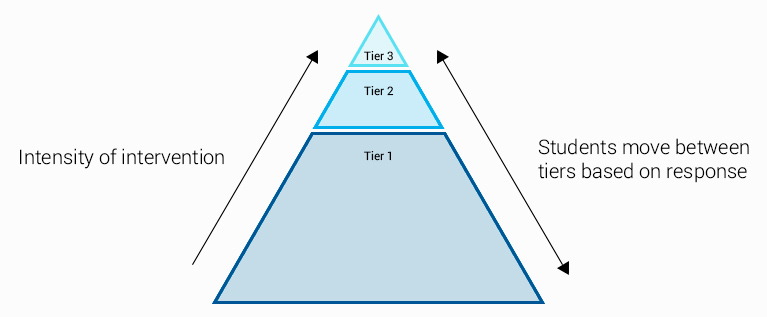November 9, 2017
Successful Tier 2 intervention
As mentioned in a previous post, multi-tier systems of support work. Now, let’s explore how they work. More precisely, let’s seek to find the ground truth—information gleaned from direct observation rather than information based on inference—in scheduling time for successful Response to Intervention (RTI) Tier 2 interventions.
With the incredible opportunity to read research related to RTI, coupled with the opportunity to spend time with education leaders across the United States, drawing inferences from established practices guides my thinking on RTI. Most school systems I’ve observed tailor their RTI implementation to meet the goals of their district, students, and resources, including time and a physical space for intervention. The following examples provide an illustration of this:

- A district near Albany, New York, restructured lunch time to allow time for the meal and social interaction while adding a laser-focused block of time for supplemental instruction.
- Many districts take advantage of homeroom time to offer Tier 2 instruction and support.
- Other schools implement “What I Need” or WIN time for Tier 2 support.
The inferences drawn from these examples suggest that commitment and creativity frame the most impactful schedules for Tier 2 instruction.
A more doable approach to RTI? We think so!
Our guest author, Tonya Newsom, Curriculum Coordinator from Livingston Parish Public Schools (LPPS) in Livingston, Louisiana, shared her insights below on the parish’s new perspective on time for Tier 2 intervention.
For our district, RTI has been challenging as we have tried our best to meet individual student needs with quality instruction while tracking progress and maintaining appropriate records. Over the past two years, restructuring has been done in some of our schools, resulting in what we believe is a positive change in addressing all students. Sometimes we do things a certain way for so long that it never occurs to make a mind shift in the way we schedule work or where we do our work.
Once you experience something new, you cannot help but wonder, “Why is it so hard to change?” “Why is it so hard to see a different structure?”
Well, “seeing” is what happened for us!
After we visited two schools and their classrooms, a mind shift toward creative scheduling happened. We then realized we were seeing a trend. Some principals from our district made the visits with us, and immediately they went into a mode of reworking schedules for their students, teachers, and interventionists. We have always followed the model of pulling students from the classroom and having them go to their intervention session. Through creative scheduling, we now have some schools sending personnel resources into the classroom at a specific time so that every child in the classroom gets what he or she needs. Specifically,
- students in intervention receive instruction to close gaps in their learning, and
- students who need enrichment have an opportunity to make additional growth.
Renaissance Star Assessments data provide insight for educators to establish the most effective direction for our students. In LPPS, we actively prepare students for assessment, making sure they understand why we assess and how their data will be used. Knowing we have the best data to drive instruction helps us realize our goal of motivating students to “do your best”.
Everyone wants “his or her bucket filled.” It is great when you see all your students happy in small groups getting what they need!
Finding the ground truth
Where do you find time for effective Tier 2 interventions? How do you provide meaningful, engaging learning experiences for students not identified as needing supplemental support in Tier 2? Let us know and share your ground truth in the comments below, post on our Facebook, or tweet us at @RenLearnUS!

